Article 2 :- How rattled Pakistan began invading Jammu and Kashmir in 1947 (Jammu and Kashmir’s accession to India)
| 12-Nov-2022 |
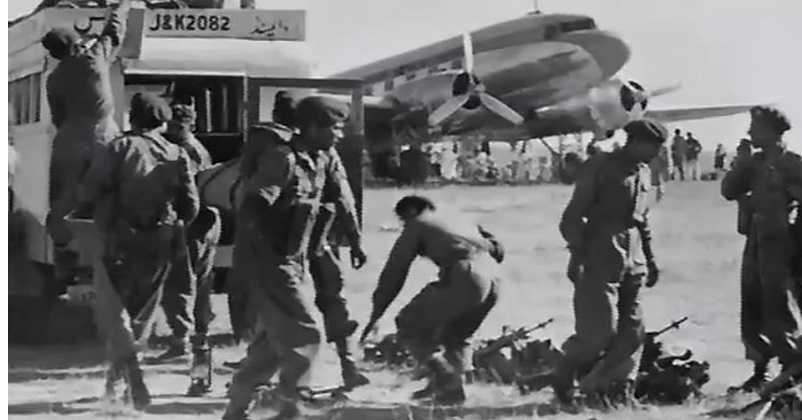
In continuation to the first article wherein Pakistani army in the guise of tribesman started invading Jammu and Kashmir in 1947, the civil administration at Srinagar totally collapsed. On 25 October, Maharaja Hari Singh left Srinagar for Jammu which was the winter capital of the state. The then Prime Minister of the state, Mehar Chand Mahajan was also away. The subordinate officials, the police chiefs and public servants, all left their jobs and looked anxiously to the safety of themselves and their families.
Accession to India:-
By the latter half of October 1947, the Government of India was in close touch with the situation in Kashmir. The Maharaja's government also informed the Government of India of the worsening situation within the State and sought help in controlling it. Direct assistance of the Indian Army was out of the question till Jammu and Kashmir had acceded to India, but before any help could actually be sent, the tribesmen had invaded Kashmir, changing entirely the complexion of affairs.
It was only on 24 October that the Government of India got the first news of the invasion of Kashmir. A message was received from Pakistan Army Headquarters that day, informing the Supreme Commander that "Tribesmen estimated 5,000 Afridis, Wazirs, Mahsuds, Swatis attacked Muzaffarabad and Domel capturing both on 22 October. Tribesmen reported approaching Srinagar. Kohala in danger of being attacked. Tribesmen in large numbers expected to go Kashmir."
Then, at 11 p.m. the same night, an urgent request was received from Maharaja Hari Singh, specifically asking for Indian troops to be sent to Kashmir to save it from the invaders. This S.O.S. of the Kashmir government was considered in Defence Committee of the Cabinet on 25 October. But the difficulties of the undertaking were all too obvious. No plan had ever been made for sending Indian troops to Kashmir. Srinagar was over 480 km from the nearest point of the Indian border. Troops in the East Punjab were fully engaged in rescuing refugees and maintaining law and order.
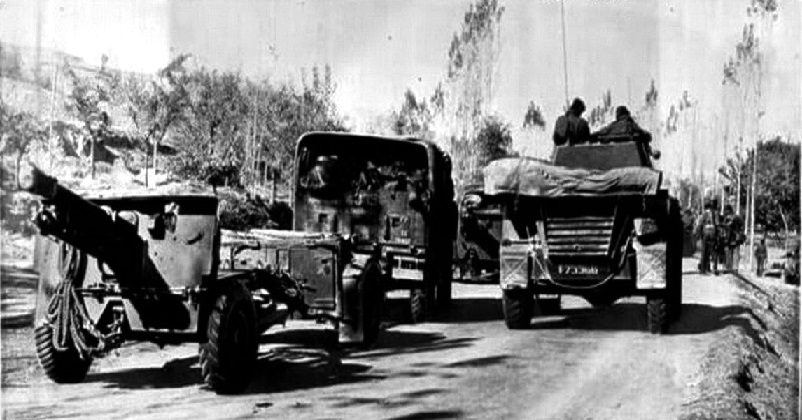 A Pakistan army convoy advances in kashmir
A Pakistan army convoy advances in kashmir There was no time to lose, for the way to Srinagar lay open to the raiders, with only a handful of State troops to push aside. Air transport of troops was the only way out, but that presented unprecedented problems. The Srinagar landing ground, situated at the altitude of 1524 metres, fell far short of international standards, and was not even regularly maintained. Landing large, fully-laden transport planes on this airstrip would be in itself a feat.
The troops would then find themselves stranded in a distant valley with no depots, ancillary services or regular line of communication. They would be entirely dependent on the uncertain air transport for all their multifarious needs, and faced with an enemy, about whom they had little information.
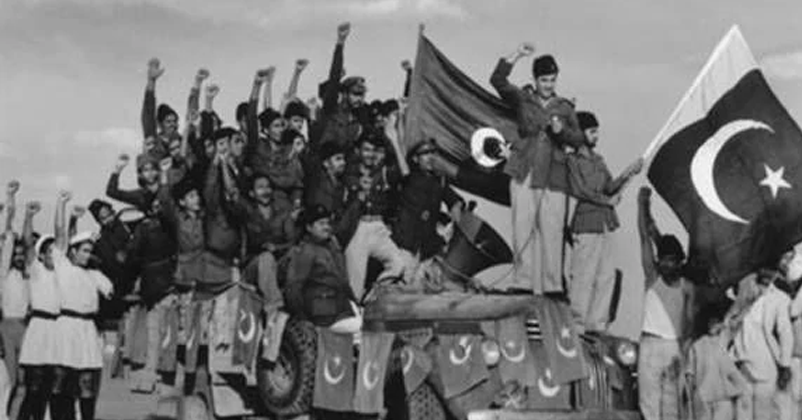
To assess the situation, V.P. Menon (Secretary, Ministry of States, Government of India) was flown to Srinagar on 25 October. He found the city plunged in gloom and expecting the raiders' arrival any time. On his advice, the Maharaja of Jammu and Kashmir left Srinagar for Jammu late that night, to escape from being captured by the raiders who could then extract from him whatever they wanted.
Menon returned from Srinagar in the morning of 26 October, accompanied by M.C. Mahajan, the Prime Minister of Jammu and Kashmir. The Defence Committee of Cabinet discussed the situation and the urgent pleas of the State government . It was decided that Indian troops would be sent to the State only after its formal accession to India. V.P. Menon flew to Jammu that afternoon and immediately returned with the formal Instrument of Accession signed by the Maharaja.* With the acceptance of this legal document by the Governor-General of India on the evening of 26 October 1947, the State of Jammu and Kashmir became an integral part of the Indian Dominion, legally, morally and constitutionally.
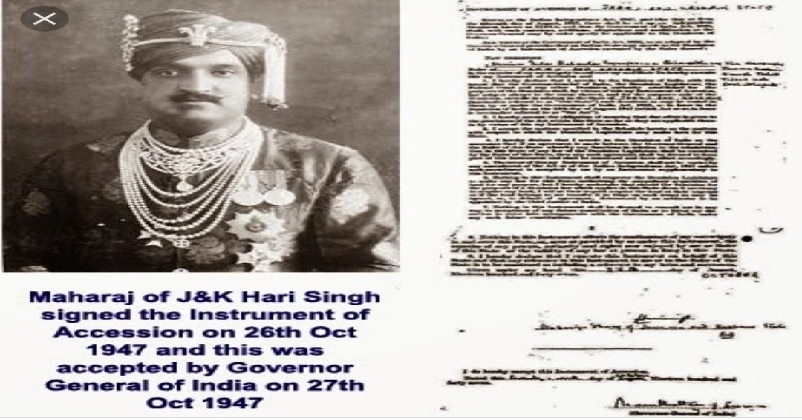
Instrument of Accession
When the Governor-General of Pakistan came to know of the despatch of Indian troops to Srinagar on 27 October, he became furious. That night he sent instructions to Gen Sir Douglas Gracey, the acting Commander-in-Chief of the Pakistan Army (Gen Messervy, the C-in-C, was away on leave) to move the Pakistan Army into Kashmir to seize Baramula, Srinagar and the Banihal Pass as well as to move into Mirpur district of Jammu. However, Gen Gracey replied that he could not take such action without consulting the Supreme Commander, Field Marshal Auchinleck.
Next morning, the Field Marshal came to Lahore to explain to Jinnah that in view of the accession of Jammu and Kashmir to India, the despatch of Indian troops to Srinagar was perfectly legal, and if the Governor-General of Pakistan insisted on sending his army to Jammu and Kashmir, all British officers and men serving in the Pakistan Army would have to be pulled out at once. Consequently, Jinnah had to climb down and cancel his orders.
The first fly in :-
Though on 26 October Jammu and Kashmir became a part of India in law, it was most urgent that its invaders were thrown back. This meant that regular Indian troops must be sent there with the utmost speed. In the Army HQ, Brig Kalwant Singh, the acting CGS, took urgent steps to find and prepare the troops to be sent to Srinagar. The choice fell on 1 Sikh then stationed near Gurgaon and commanded by Lieut-Colonel D.R. Rai.
The Operation Instruction issued to him informed him that the State of Jammu and Kashmir had acceded to India but was being invaded by tribesmen from Pakistan. To save the State from the invaders, one battalion was to be flown immediately to Srinagar, and later, in what was described as Phase II of the Operation, a Brigade Group would be moved to Jammu. Lieut-Colonel Rai's task was to fly to Srinagar early on the 27th morning with the troops allotted to him and to secure the aerodrome and civil aviation wireless station there.
Then, if possible, he was to drive away the enemy from the neighbourhood of Srinagar and aid the local government in maintaining law and order.
Each civil Dakota was to carry 15 men with their personal arms and bed-rolls, plus 225 kg of supplies; each Royal Indian Air Force Dakota was to carry an additional two men. Every flight was to be tactically and administratively self-contained, so that if necessary troops could go into action immediately on landing. In the third or the fourth flight were to be carried one officer and two NCOs of the RIE to instruct survivors of the State troops in the rudiments of bridge demolition, a Liaison Officer (Brigadier Hira Lal Atal) from Army Headquarters (India) to the local government, another Liaison Officer from the States Ministry and an Intelligence Officer from the Directorate of Military Operations and Intelligence, also three cipher operators and a medical detachment of two officers and ten men.
So uncertain was the situation in the Valley that Lieut-Colonel Rai was instructed to circle the Srinagar airfield and carefully scan the countryside in case the raiders had already occupied it. If so, he was to fly back and land with his men at Jammu. Such a rider to an Operation Instruction must surely be unique in modern military history, and was an indication of the unique uncertainty, hazards and difficulties facing the Indian troops when they went to Kashmir.
The First Flight:-
After an uneventful flight, the Dakota carrying Lieut-Colonel Rai touched down at Srinagar airfield at 0830 hours on 27 October 1947. Other planes of the first flight landed soon after and by 1000 hours Army Headquarters was informed that the first party was at last in Srinagar. The situation then was critical in the extreme. The large raider-horde was being held by only two platoons of State troops who had dug themselves in on a high ground about 5 km east of Baramulla. The handful of defenders were very hard pressed, and if they were overrun, the road to Srinagar would be open to the tribesmen.
The only reserve, or garrison, available at Srinagar was a squadron of horsed cavalry. So Lieut-Colonel Rai decided to send forward his sole company of troops immediately to reinforce the two platoons of the State forces. This was accomplished by 1200 hours on 27 October. About the same time he signalled back to Delhi, "…... 500 enemy and 2000 locals near Baramulla cannot be held by State forces, so will undertake task I and reinforce State troops to prevent break-through. Build up must be expedited." At 1500 hours the same day i.e. 27 October, another message was received at Delhi saying that Baramulla had definitely fallen and was in flames.
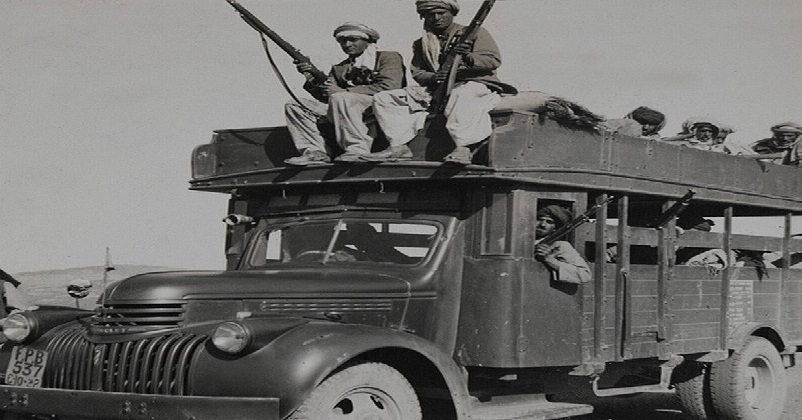
Pashtun warriors from different tribes on their way to Kashmir
In all only some 700 men of the State forces were available, and at least two companies of Indian troops were urgently required to patrol north and south of the main road in order to prevent the enemy from by-passing the Sikh positions during the hours of darkness. There was hope of some delay in the enemy advance for the tribal raiders were just then busy looting Baramulla.
But unless 1 Sikh was made up to full strength by the afternoon of 28 October, Rai was not confident of being able to save Srinagar. Soon after this message, another was received from Brigadier Hira Lal Atal, who had been sent as Liaison Officer with the State government, but without any operational control over the Indian troops.
Atal reported that the civil administration had ceased to exist, refugees were thronging the airport and that at least one brigade would be required for the defence of the Valley. In reply to his messages, Lieut-Colonel Rai was informed at 2305 hours on 27 October that air strafing would be carried out on 28 October, and the Brigade Tactical Headquarters and one extra battalion would be flown to Srinagar on 29-30 October, followed by another battalion by air if possible, else, by road.
At the same time, on 27 October, Delhi and East Punjab Command was ordered to establish a proper line of communication from Pathankot to Jammu as soon as possible. There was then only a fair weather motor road between the two places, and all traffic on it had to be ferried across the Ravi. There were only two boats available at the ferry which could transport about one battalion and 30 jeeps across the river per day. But the Engineer-in-Chief reported that the Ravi could be bridged at Kathua by one 55-metre Bailey bridge, which could be put up earliest by 7 November.
The defenders of Srinagar passed the night of 27/28 October in vigilance in their hastily dug positions east of Baramula. But no attack developed that night. The next morning, Rai himself went forward to the front line trenches with two more companies of 1 Sikh. He even contemplated attacking Baramulla and throwing out the raiders in short order. But soon after his arrival, the enemy began a big attack in order to push through and reach Srinagar. Bitter fighting took place and the attackers were held, but after some hours it struck them that the small defensive position could easily be out-flanked.
When the enemy began to encircle his position, Rai went back and selected another defensive position 8 km nearer to Srinagar. After this reconnaissance, he returned to his men and ordered them to withdraw to the new positions. Quietly and skilfully the men fell back. While seeing off the last of the rearguard, Lieut-Colonel Rai was hit in the head by a stray bullet and fell.
Death was almost instantaneous.
Thus fell a gallant son of India, in defence of freedom and of the weak. Lieut-Colonel D.R. Rai was given posthumously the award of Maha Vir Chakra.
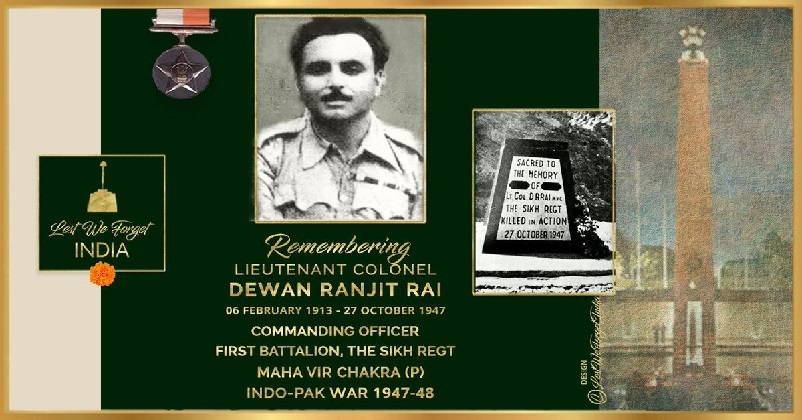
To be continued…,…